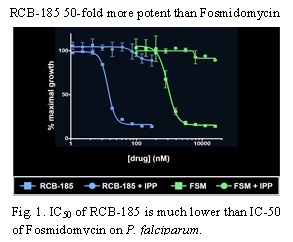GW researchers synthesized the new small molecule, RCB-185, and initially showed efficacy against Mycobacterium tuberculosis (Mtb), but now demonstrate much higher efficacy against malaria. According to the World Health Organization, 2015 had 212 million cases of malaria with 429,000 deaths. People desperately need new treatments for malaria, as use of the newest anti-malarial, artemisinin, dates to the 1990’s and artemisinin resistance is spreading. RCB-185 targets Dxr, which is a key enzyme in the non-mevalonate pathway of isoprenoid synthesis. Isoprenoids are essential, but humans use a different pathway for synthesis. RCB-185 improves upon the structure of the Dxr-inhibiting drug, fosmidomycin, which made it to phase 2 clinical trials.
RCB-185 has an IC50 of 18 nM against cultured Plasmodium falciparum (a key malaria parasite). That is about 50-fold better than the Fosmidomycin IC50. RCB-185 works equally well against P. falciparum strains resistant to common anti-malarial drugs. Mouse in vivo data also shows the effectiveness of RCB-185 against malaria.

Applications:
A therapeutic treatment for malaria
Advantages:
1. Kills parasites with low nM potency
2. Effective against drug resistant parasites
3. Targets isoprenoid pathway not used by humans